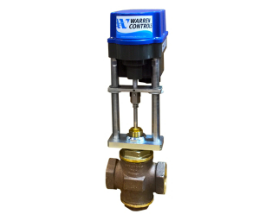A valve may seem like simple mechanical device, but valves have a major impact on everything. They control our home plumbing systems, and they control massive industrial systems! Whether it’s controlling the flow of water through pipes, regulating air pressures in engines, or managing fluids in complex chemical processes, valves play a critical role in the functionality of countless systems.
What Is a Valve?
A valve is a mechanical device that controls the flow of a liquid, gas, or slurry through a systematic passageway such as pipes. A valve achieves control of a liquid, gas, or slurry by stopping or starting the flow, varying the amount of fluid flow, controlling the direction of the flow, regulating downstream system or process pressure, and relieving component or piping over pressure. Think of a valve like a faucet in your kitchen or bathroom sink: by turning the handle you control and flow of the water.
What Components Make Up a Valve?
Well, if valves vary significantly depending on the application what constitutes a valve? All valves will be made up of the same basic components: a body, bonnet, trim (internal elements), actuator, and packing.
Body – Valve bodies are the primary components of valves, responsible for regulating the flow of fluids. They function as the housing for internal components such as the stem, disc, and seat. They are cast or forged into a variety of shapes.
Bonnet – Valve bonnets are the part of the valve body that covers the opening on top of the valve. The bonnet is attached to the valve body and encloses the internal parts of the valve that come into direct contact with the process fluid.
Trim – Valve trim is the internal elements of the valve such as a disk, seat, and stem.
Actuator – An actuator operates the stem and disk assembly. It may be a manually operated handwheel, manual lever, motor operator, solenoid operator, pneumatic operator, or hydraulic operator.
Packing – Packing is commonly a fibrous material such as flax or another compound such as Teflon. The packing forms a seal between the internal parts of a valve and the outside where the stem extends through the body. This prevents leakage from the space between the stem and the bonnet.
What are Some Different Types of Valves?
Gate – A gate valve is used to completely stop or allow the flow of fluids. It is often used in applications where the valve is either fully open or fully closed. When fully open, a gate valve offers minimal resistance to the flow of fluid. It is ideally used in systems where fluid flow is critical.
Ball – They are widely used for quick shut-off. They feature a spherical ball with a hole in the middle, which rotates to control the flow. When the hole aligns with the pipe, the valve is open; when it’s rotated 90 degrees the flow is shut off. Ball valves are known for their reliability, durability, and ease of operation.
Globe – Are used to regulate the flow of fluids. They are ideal for systems where precise control is necessary. Unlike gate valves, which are either fully open or fully closed, globe valves ca be partially opened to allow a controlled flow of fluid. They have a more complicated design but offer better performance in situations requiring flow regulation.
Pressure Relief – Are designed to open automatically when the pressure within a system exceeds a certain threshold, preventing over-pressurization. They are commonly used in boilers, air compressors, and gas pipelines to maintain safe operating conditions.
Butterfly – Uses a rotating disk to controls the flow fluids. It’s commonly used for larger pipes and systems where space is limited. Butterfly valves offer quick shut-off, low maintenance, and are lightweight, making them ideal for both large-scale industrial applications and smaller systems.
Needle – Has a need-like mechanism that provides precise control over the flow of fluid, making it ideal for application where small flow adjustments are needed, such as in instrumentation and laboratory settings.
What Industries Do They Serve?
Industries that valves serve are plumbing and HVAC systems, oil and gas industry, power plants, chemical, pharmaceutical, and water/wastewater treatment.

